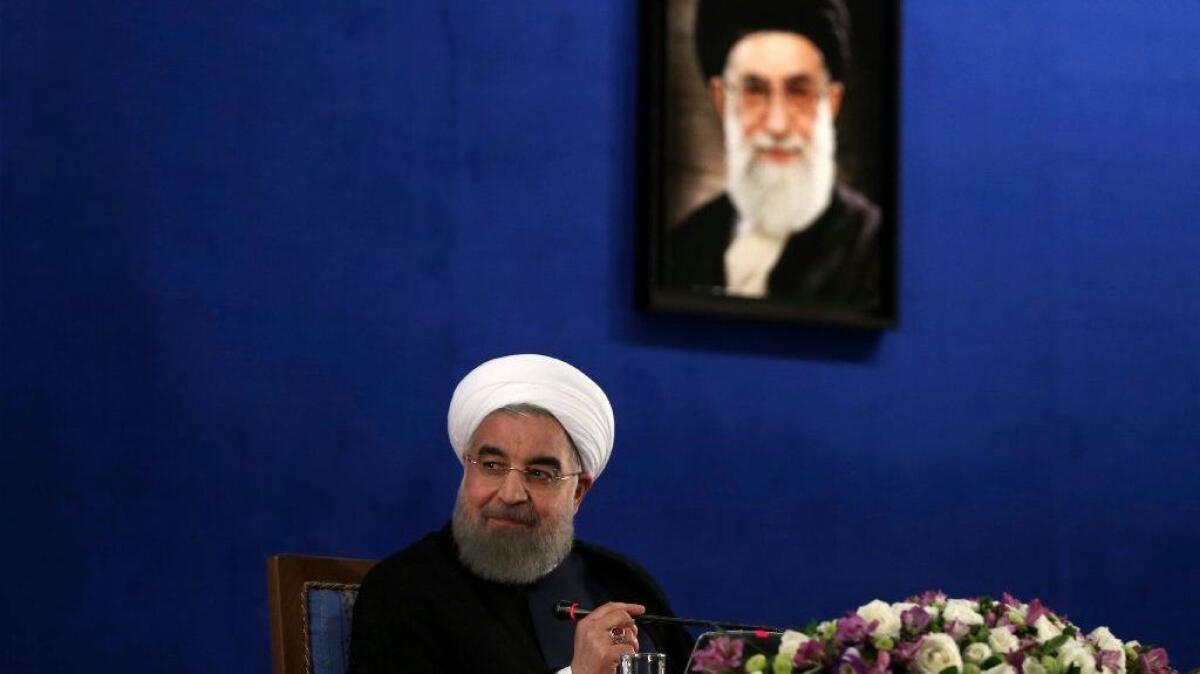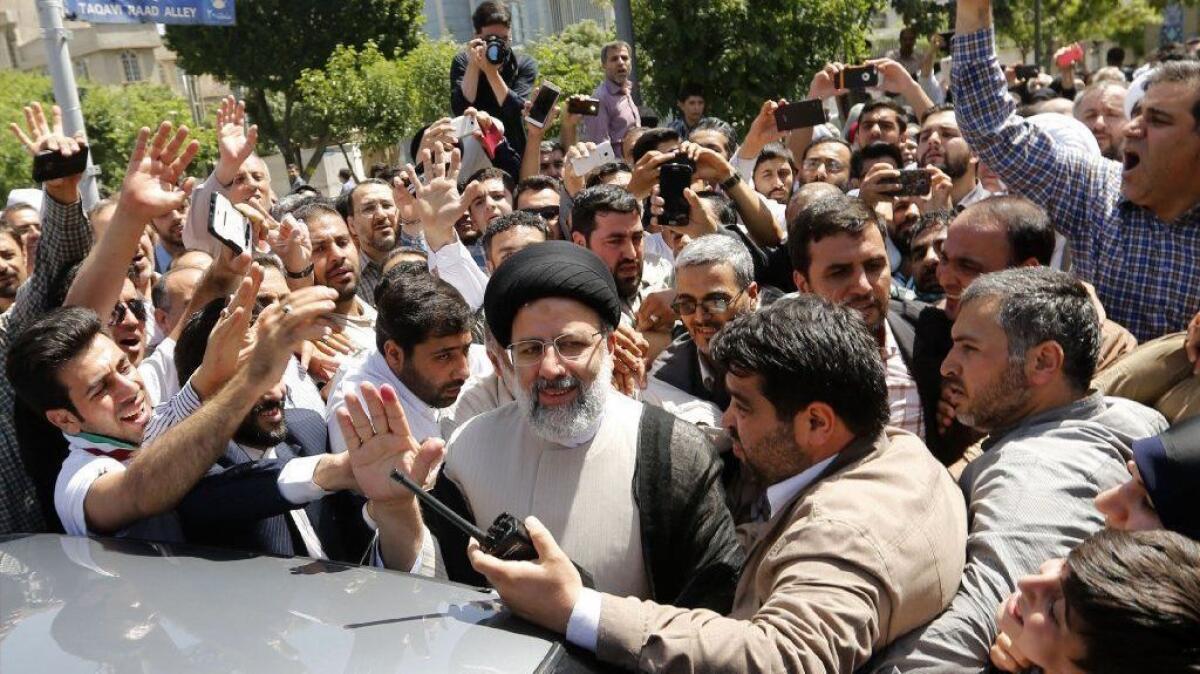Q&A: After Iranians’ vote for reform, a bigger question looms: Who will be the next supreme leader?

- Share via
After President
Although the topic is taboo in Iran, the question of who will succeed Khamenei, who is 77 and ailing, reportedly from prostate cancer, loomed over the May 19 election. Rouhani, a relative moderate, won 57% of the vote in a four-man field, demonstrating strong public support for his policies of economic pragmatism, international engagement and expanding social freedoms.
But in Iran’s theocracy, one vote matters most: that of the supreme leader.
Khamenei and the hard-line “principlist” faction that is close to him have indicated impatience with Rouhani’s economic policies and outreach to the West — especially the 2015 nuclear agreement.
Following the election results, Khamenei congratulated Iranians on a stout 75% voter turnout but did not mention Rouhani, who captured a second four-year term. The move fueled speculation of a rift and led some observers to predict that the supreme leader would curtail the president’s reform efforts by anointing a fellow hard-liner to succeed him.
Here are the key questions surrounding Iran’s leadership transition:
How important is the selection of the new supreme leader?
Extremely important. Ali Vaez, Iran analyst for the International Crisis Group, calls it “the most pivotal moment in the history of the Islamic Republic.”
The supreme leader has the last word on all domestic and international policies, and Khamenei is only the second man to lead Iran since the 1979 Islamic Revolution. His successor will be tasked with winning over a youthful population — half of Iranians are younger than 30 — that wants more openness and less confrontation.
“The majority of the people have no firsthand experience of what the revolution was and the ideals that people fought for,” said Amin Farroukhi, a PhD student in Tehran.
But the transition comes as Iran’s ruling establishment faces growing instability abroad, including from a Trump administration that wants to isolate Iran and is cozying up to Tehran’s archenemy, Saudi Arabia. The growing tensions could produce a more hawkish successor.
Read more: How Iran's urban middle class uses dogs and weddings to push for more social freedoms »
How is he chosen? (Yes, it’s always been a ‘he.’)
Upon the leader’s death, an 88-member, all-male council known as the Assembly of Experts votes in a secretive process not unlike the selection of the pope. A two-thirds majority is required, and a committee is already considering possible candidates.
Khamenei ascended to the position in 1989 after the death of the founding supreme leader, Ayatollah Ruhollah Khomeini. Former President Ali Akbar Hashemi Rafsanjani virtually guaranteed Khamenei’s accession by announcing that he had been Khomeini’s choice to succeed him.
Rafsanjani, a wily political operator, died in January, and there is no one of his stature to mastermind another transition, especially with Iran so polarized between reformists and hard-liners.
“The authority that Khomeini’s words had back then, and that someone like Rafsanjani had back then… I’m not sure those dynamics will play out this time,” said Adnan Tabatabai, chief executive of the Berlin-based Center for Applied Research in Partnership with the Orient.
In that vacuum, Iran’s security establishment, led by the elite Revolutionary Guard, could seek to control the process and ensure the appointment of a hard-line leader who would oppose sweeping reforms or rapprochement with the West that would threaten the Guard’s economic and political interests.
[The transition represents] the most pivotal moment in the history of the Islamic Republic.
— Ali Vaez, International Crisis Group
Has Khamenei indicated a choice for his successor?
Not explicitly. But he is widely believed to favor someone like Ebrahim Raisi, whom Rouhani defeated in the election.
Raisi, 56, was a relatively obscure former judge when Khamenei selected him in March 2016 to head Iran’s wealthiest religious foundation. This year, when Raisi declared his candidacy for president, it suggested that hard-liners close to Khamenei were aiming to raise Raisi’s stature to position him as a potential successor.
Although urban middle-class Iranians rejected Raisi’s ultra-conservative views — as a judge he reportedly presided over the executions of political prisoners — he became a household name and managed almost 37% of the vote
“He won 16 million votes and went from anonymity to the spotlight in 40 days,” said Hamid Reza Taraghi, a political analyst who is close to Khamenei’s office. “I am sure that if the campaign had lasted 60 days, he would be the president-elect. In the years to come, he has a chance to promote himself and be one of the candidates for succession.”
Raisi has continued making public appearances since the election, signaling that he intends to keep building his profile.

Can Rouhani and the moderates influence the process?
Although Rouhani’s camp made gains in last year’s elections to the Assembly of Experts, it is still controlled by hard-liners. Rouhani is believed to covet the leadership, but analysts say his best hope is to try to enthrone a fellow pragmatist.
That will be difficult. Although Rouhani is a member of the assembly, hardly any fellow members supported him in the election, Taraghi said.
If Khamenei dies during Rouhani’s term and the assembly fails to agree on a successor immediately, Rouhani would form part of a temporary three-member council that would assume the supreme leader’s powers until a replacement is elected.
Did the election have any impact?
Iran’s moderate and reformist faction has now won three straight national elections and controls the presidency as well as parliament. The clerical establishment relies on the elections to legitimize its rule, and experts say that hard-liners know they risk social unrest if they don’t acknowledge the voters’ will.
That could insert a new factor into the discussion of Khamenei’s replacement: popularity.
“In addition to someone who is well connected with the clerical, security and political establishments, he will need some sort of broad-based acceptance among the people,” Tabatabai said.
Rouhani’s backers say they will continue to press for reforms, such as the release of opposition Green Movement leaders from house arrest, which the president supported. Pro-Rouhani campaign rallies echoed with slogans such as: “Our message is clear — the house arrests should be lifted.”
“In recent weeks you see Green Movement slogans even in small towns, and someday this can be a nationwide slogan,” said Siavash Ramesh, a 28-year-old tour guide and activist. “We have to make good on these slogans and fight for accountability from the current supreme leader and his successor.”
Special correspondent Mostaghim reported from Tehran and Times staff writer Bengali from Mumbai, India.
Follow @SBengali on Twitter for more news from South Asia
ALSO
90 reportedly killed and 400 wounded after car bomb goes off in Kabul
Violence breaks out in Afghanistan's capital during a protest about a deadly bombing
Islamic State claims responsibility for attack on Coptic Christians in Egypt that left 29 dead
Sign up for Essential California
The most important California stories and recommendations in your inbox every morning.
You may occasionally receive promotional content from the Los Angeles Times.







